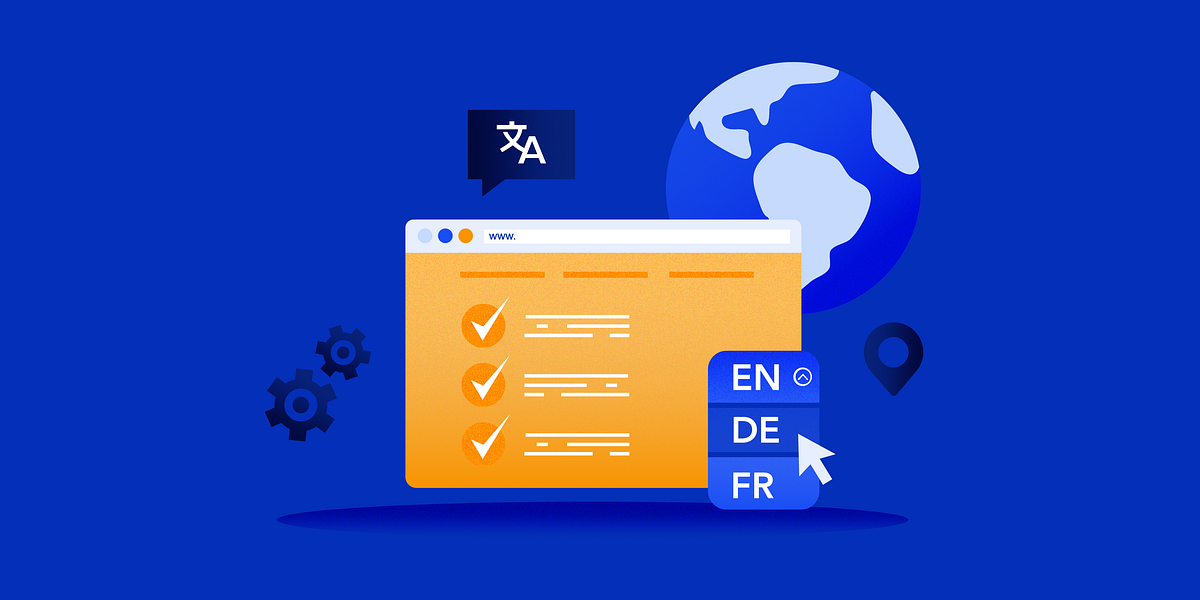
5 methods to translate a website
“Translate Website” is a popular keyword for most website owners now because of its benefits for SEO and increasing the global reach of your brand. But effective website translation is more involved than simply copying and pasting text into the Google Web Translation plugin.
There are a few webmasters who still use Google Web Translation tool – but they risk reducing the value of their company brand- and even the company reputation. Errors in translation, misspelling, or just the wrong context will cost them a share of the organic search market.
According to BuiltWith Insights, 27% of top 100,000 websites are in English. The rest are non-English websites, demonstrating the importance of having a localized environment rather than relying on a basic English version for all visitors.
Any website engaging with international web traffic should localize their website and content marketing materials using a more professional method of translation, instead of embedding the Google Translation widget and hoping everything will be fine.
There are five key methods you can use for website translation and localisation, each with their own pros and cons. This is what you need to know:
Method 1: Copy & Paste based translation
How does it work?
Copy & Paste is one of the simplest website translation methods because it does not require any additional technology behind your website, and is relatively easy to use. Using this technique, the Webmaster will copy every sentence or phrase into a Google Sheet. That Google Sheet is then shared with the translator, who adds the necessary translations. The new text is then copied and pasted into the new localised pages of your website.
How to get started
- Create a Google Drive folder to store the text;
- Create a new Google Sheet with the text to be translated for each website inside the new folder;
- Share the folder with your translation provider or Travod;
- Once complete, the translated text can be copied from the updated Google Sheets.
Method Quality
The Copy & Paste translation method is not foolproof. Humans can make errors copying and pasting text, copying twice, pasting the same text three times, or even forgetting to copy whole sentences. Because the person doing the copy/paste does not speak the translated language, they will be unable to spot any errors.
Method Cost
Because this method does not use any technology, there are no tech-related costs. The only costs you will incur is the translation fee which may be charged by your translation provider or Travod Project manager, and the time/resources allocated to the copy/paste activities.
Method 2: Plugin based translation
How does it work?
Plugin based translating is mostly used by CMS or E-commerce applications like Shopify, BigCommerce, WordPress, Drupal, WIX and other similar apps. The beauty of plugin based translation is that you share access to your website with your translation provider or Travod, who then translate directly the text on your website directly. All updates are performed in real time without any interruptions.
How to get started:
- Search for a “Translation Plugin” in your web marketplace (“Shopify translation plugin”, “WordPress translation plugin” etc depending on your platform);
- Provide your translator with a login for your CMS or e-commerce platform;
- Travod or your translation provider will create new localised web pages based on the existing content and save it as a draft;
- When you are happy that the translation meets quality standards, you can publish the new pages in your own time.
Method Quality
Using plugin based translation is the best choice for webmaster because localised content can be published as soon as it is created. Plugin based translations also avoid the risk of human error inherent in copy/paste translation.
Method Cost
Some translation plugins are free, others are paid (around $15). You will almost always be able to find an adequate plugin for free; the only cost you will incur is the translation agency’s fees.
Method 3: Dynamic Content-based translation
How does it work?
Dynamic Content translation takes every method further by allowing translators to translate the content using a visual editor on the website instead of creating and uploading files manually. This method provides even higher quality localised content. Translation syntax and context will be approaching 100% accuracy with the original language intent. Dynamic Content translation is only available from a few translation companies.
This is the simplest method from the webmaster’s perspective as virtually everything – including publishing – can be done by the Translator cloud network.
How to get started:
- Sign up with your chosen translation provider;
- You will be supplied with a small code snippet – follow the accompanying instructions to add it to your website;
- The translator will translate your website visually, saving the content to your cloud network space;
- You review and publish the updates.
Method Quality
Using Dynamic Content translation provides the best quality translated by retaining the context and intent of the original. The translator can also adjust word count and phrasing to better fit text to the page layout.
Method Cost
Dynamic Content translation is usually offered as a monthly subscription, with translated content being saved to the cloud. Your monthly fee covers cloud usage and delivery. Pricing varies between $29 and $400 per month depending on the complexity of the website.
Method 4: Word Extraction based translation
How does it work?
Word extraction is another method of translation, used when the page is not structured, has many sub-pages or child items, different content workflows and content animations. Text is extracted automatically from the website using special ‘scraping’ tools and forwarded to the translator for conversion. Using automation means that no text is missed during the extraction process.
How to get started
For this method to work, the webmaster needs to have knowledge of content scraping/content indexing/content spidering using tools to collect all the information from every page. Few webmasters have knowledge of these tools, however. For this reason, you should find a translation agency which provides website data extraction services to extract text from your website.
Method Quality
Using this method, the translation quality will be very poor. The words are extracted from your pages, but the context, structure and syntax of the default language are lost during the scraping process. The translated content will probably be very different from the original. The quality may be acceptable when the extracted data is related to content databases where there is no subtlety or inference in the text.
Method Cost
If your webmaster performs the data extraction, they may have to use scraping tools, data extraction tools or website extraction tools which cost between $50 and $200. If your webmaster works directly with a translation agency, the data and content extraction may be included in the service for free.
Method 5: File Extraction based translation
How does it work
The file extraction method is commonly used by translation agencies to make your job easier. By providing FTP access to your website database, the translation company will export raw files and database content themselves. They then translate the text and push it back to your website using FTP. Although common, this method can be problematic for companies that have dynamic web pages or a particularly complex website.
How to get started
The file extraction method is relatively straightforward:
- Using Cpanel or FTP, create file access permissions for the translation company;
- The translation company converts the text;
- The translated files are re-uploaded to your web server.
When it comes to translating database content, the webmaster will need to filter the database providing the translation agency with access to the content tables. The database behind your content management system (usually MySQL) contains everything from passwords to personal data, so it is vital that access is restricted to include only the website text.
Method Quality
This method is generally quite effective. The translated content will retain its logic as the translators can translate the content while viewing the original webpage directly. But in regards to website complexity, the downloaded version may have some hidden elements which are triggered based on Javascript; if the translator cannot see this content, they may miss some words. In general, if the website is basic, this method is very easy for both parties. If the website is more complex, then we don’t recommend this method.
Method Cost
Aside from the translation service, this method does not cost anything extra as every webmaster has access to their Cpanel & FTP account.
Going through the five methods of website translation, much has changed in the past 20 years, as more technology is used to provide better results more quickly. It is still important that your webmaster uses the right method of translation for your website so they provide the highest quality product and content to your clients.
As new technologies are developed, it now takes just a matter of hours to translate a website (basic or complex). Twenty years ago it could take 30 days (or more) to translate an entire website. But as more visitors use your website, it is vital that you provide localised content – to keep them engaged, and to help your business generate more sales.
Do you have a website translation project?
Let us help. Complete this form and one our Translation experts will contact you with a quote and proposed delivery date.
Subscribe for more
Stay up to date with the latest articles, news and translation insights


